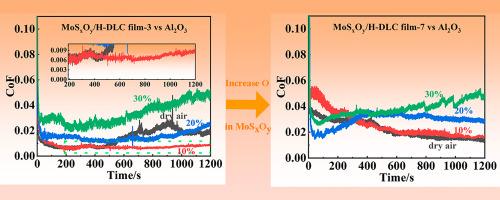Superlubricity of MoSxOy/H-DLC composite in dry and moist air
IF 5.1
3区 材料科学
Q2 MATERIALS SCIENCE, COATINGS & FILMS
引用次数: 0
Abstract
The engineering application of superlubricity in dry and moist atmospheres is critical for reducing friction, wear, and economic consumption. The MoS2/H-DLC composite can achieve superlubricity in oxygen, which can help to quickly form a MoS2 transfer film on the surface of counterpart at the initial sliding stage. However, the friction performances of MoS2/H-DLC composite were still unclear in dry and moist air when these MoS2 flakes were doped with oxygen. Regarding this problem, we constructed some MoSxOy/H-DLC composites with different degree of oxidation, and their friction performances were investigated in dry and moist air with relative humidities of approximately 10 %, 20 %, and 30 %. Superlubricity was achieved by the composite in dry and moist air with a relative humidity of approximately 10 %. Raman, AFM, SEM-EDS, and TEM characterizations have been conducted to reveal the composition and structures of these as-formed wear scars and tracks. These results suggested that a small number of water molecules in the atmosphere could promote the formation of the MoSxOy transfer film on an Al2O3 ball, which was crucial for achieving superlow friction in moist air. These findings provide some helpful suggestions for obtaining superlow friction in moist air.

MoSxOy/H-DLC复合材料在干湿空气中的超润滑性
超润滑性在干燥和潮湿环境中的工程应用对于减少摩擦、磨损和经济消耗至关重要。MoS2/H-DLC复合材料在氧环境下具有超润滑性,有助于在初始滑动阶段在对相表面快速形成MoS2转移膜。然而,当这些MoS2薄片掺杂氧气时,MoS2/H-DLC复合材料在干燥和潮湿空气中的摩擦性能仍然不清楚。针对这一问题,我们构建了不同氧化程度的MoSxOy/H-DLC复合材料,研究了其在相对湿度分别为10%、20%和30%的干燥和潮湿空气中的摩擦性能。该复合材料在相对湿度约为10%的干燥和潮湿空气中实现了超润滑性。通过拉曼、原子力显微镜、SEM-EDS和TEM表征,揭示了这些形成的磨损痕和轨迹的组成和结构。这些结果表明,大气中少量的水分子可以促进Al2O3球上MoSxOy转移膜的形成,这是在潮湿空气中实现超低摩擦的关键。这些发现为在潮湿空气中获得超低摩擦提供了一些有益的建议。
本文章由计算机程序翻译,如有差异,请以英文原文为准。
求助全文
约1分钟内获得全文
求助全文
来源期刊

Diamond and Related Materials
工程技术-材料科学:综合
CiteScore
6.00
自引率
14.60%
发文量
702
审稿时长
2.1 months
期刊介绍:
DRM is a leading international journal that publishes new fundamental and applied research on all forms of diamond, the integration of diamond with other advanced materials and development of technologies exploiting diamond. The synthesis, characterization and processing of single crystal diamond, polycrystalline films, nanodiamond powders and heterostructures with other advanced materials are encouraged topics for technical and review articles. In addition to diamond, the journal publishes manuscripts on the synthesis, characterization and application of other related materials including diamond-like carbons, carbon nanotubes, graphene, and boron and carbon nitrides. Articles are sought on the chemical functionalization of diamond and related materials as well as their use in electrochemistry, energy storage and conversion, chemical and biological sensing, imaging, thermal management, photonic and quantum applications, electron emission and electronic devices.
The International Conference on Diamond and Carbon Materials has evolved into the largest and most well attended forum in the field of diamond, providing a forum to showcase the latest results in the science and technology of diamond and other carbon materials such as carbon nanotubes, graphene, and diamond-like carbon. Run annually in association with Diamond and Related Materials the conference provides junior and established researchers the opportunity to exchange the latest results ranging from fundamental physical and chemical concepts to applied research focusing on the next generation carbon-based devices.
 求助内容:
求助内容: 应助结果提醒方式:
应助结果提醒方式:


